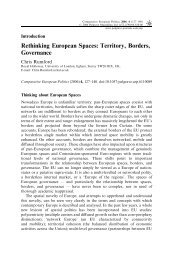Europeanisation, National Identities and Migration ... - europeanization
Europeanisation, National Identities and Migration ... - europeanization
Europeanisation, National Identities and Migration ... - europeanization
You also want an ePaper? Increase the reach of your titles
YUMPU automatically turns print PDFs into web optimized ePapers that Google loves.
242 Judit Tóth <strong>and</strong> Endre Sik<br />
studies with politicians (both in Hungary <strong>and</strong> in the ethnic Hungarian community<br />
across the Hungarian border) deeply involved with Diaspora politics.<br />
4 Similarly, a Chinese identity is the only characteristic of the Chinese Diaspora,<br />
whereas the Chinese of China will far sooner identify with a particular province. The<br />
power of a ‘Pan-Chinese’ identity stems partly form the ‘lowest common denominator’<br />
<strong>and</strong> partly a product of China’s Diaspora-policies (Nyiri 2001). Further, this is the<br />
identity-element which is meaningful for the foreigner, which is why it provides the<br />
individual living in Diaspora with a ‘usable’ identity.<br />
5 Constitution, para 6 (3), enacted by Act XXXI of 1989, para 2, in force as of 23<br />
October 1989.<br />
6 Government Decree No. 90/1992, 29 May 1992, replacing the Secretariat of<br />
Hungarians Across the Borders inside the Prime Minister’s Office.<br />
7 Parliamentary Resolution No. 26 of 1999, 26 March.<br />
8 Government Resolution No. 1079 of 1999, 7 July.<br />
9 Act No. LXII of 2001, which entered into force on 1 January 2002.<br />
10 The frontier along the Hungarian–Romanian border depends on how <strong>and</strong> when<br />
Romania could be removed from the common list of countries requiring a visa, in<br />
accordance with the EU’s requirements (500PC0027 document of the Commission,<br />
issued on 28 February 2000).<br />
11 See the Conference report with recommendations on the reshaping of Europe’s<br />
borders: Challenges for EU <strong>and</strong> External Policy (Centre for European Policy Studies –<br />
Sitra Foundation <strong>and</strong> Stefan Bathory Foundation, Brussels, 6/7 July 2001: New<br />
European Borders <strong>and</strong> Security Cooperation – Promoting Trust in an Enlarged<br />
Union).<br />
12 ‘The Republic of Hungary, in order to ensure the maintenance of permanent contacts,<br />
provide for the accessibility of benefits <strong>and</strong> supports defined in this Act, ensure<br />
undisturbed cultural, economic <strong>and</strong> family relations, ensure the free movement of<br />
persons <strong>and</strong> the free flow of ideas, <strong>and</strong> taking into account her international legal<br />
obligations, shall provide for the most benefited [favoured] treatment in the given<br />
circumstances that are possible with regard to the entry <strong>and</strong> stay on its territory for the<br />
persons falling within the scope of this Act’ (Article 3).<br />
13 Letter exchange between Mr Zsolt Német <strong>and</strong> Mr Joszef Krasznai (Deputy leader of<br />
the Roma Parliament) Annex No. 3 to Paper Containing the Position of the Hungarian<br />
Government in relation to the Act on Hungarians Living in Neighbouring Countries<br />
(Budapest, 2001).<br />
14 European Commission for Democracy Through Law (Venice Commission),<br />
Strasbourg, 22 October 2001 (CDL-INF (2001) 19) ‘Report on the preferential<br />
treatment of national minorities by their kin-state’ adopted by the Venice Commission<br />
at its 48th Plenary Meeting (Venice, 19/20 October 2001).<br />
References<br />
Bárdi, N. (2000) ‘Cleavages in cross-border Magyar minority politics 1989–1998’, Regio<br />
(Minorities, Politics, Society), Budapest: Teleki L. Institute, Centre of Central European<br />
Studies, 3–36.<br />
Béla, B. K. (1999) ‘Válasszunk magunknak új identitást’, Erdélyi Hívogató, 2, 1: 1–2.<br />
Bíró, A. Z. (1992) ‘A regionális identitáskialakításának néhány vonásáról’, Régió 3, 4: 61–71.<br />
—— (1994) ‘Adalékok a vándorló ember ikonográfiájához’, in E. Sik <strong>and</strong> J. Tóth (eds)<br />
Jönnek?Mennek?Maradnak?, Budapest: MTA PTI.<br />
—— (1996) ‘Egyéni és kollektív identitás a kilépési gyakorlatban’, in J. Bodó (ed.)<br />
Elvándorlók? Vendégmunka és életforma a Székelyföldön, Csíkszereda: KAM, Pro-Print Kiadó.<br />
—— (1998) Stratégiák vagy kényszerpályák?, Csíkszereda: KAM, Pro-Print Kiadó.



